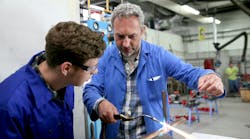Latest from Management
Sponsored
In many past columns, I have written about the woeful lack of quality trainees and apprentices in the trades and pinpointed the lack of viable educational opportunities as one of the prime reasons for the problem. In other columns, especially when discussing Douglas Greene’s STC high school trade center projects and Humberto Martinez’ Construction Career Days program, I addressed the mind set of our educators.
For whatever reason, today’s educational administrators and school boards do not consider the trades as an acceptable career path for students. At best vocational education is used as a dumping ground for problem students or those deemed “inadequate” for the college course track. It seems that the ball has started rolling lately, and those attitudes are beginning to change... very slowly, but changing they are.
Then and Now
It’s interesting to note that 50 or so years back, getting into the trades was the thing most desired for high school seniors. Then, trade craft was respected, and wages were in the upper echelon of the day. Getting into an apprenticeship program was difficult, and father/son/uncle/relative referral was common. How things have changed.
Construction wages are still higher than the average white collar wage, and blue collar benefits are generally on a par with, or greater than, those jobs. True, construction work can sometimes be seasonal, but so can white collar work. Staying for years, or decades, with one firm is no longer common. The days of long-term employment with a single company are behind us.
What do They Know?
At least with a trade education and a modicum of talent, a craftsman can still earn a living with his hands—if not with a shop, then for himself. Most white collar employees are at the mercy of available openings and must vie against many others looking for the same job.
What’s the problem here? The responses I got from readers all beat around the bush, but pretty much say the same thing: educational snobbery. There, I said it and I’m glad. Sometime over the last half century, the academic/institutional mindset decided that a college education is the gold standard of our educational system and anything that had to do with (gasp... cue the horror music) manual labor was considered beneath contempt. The folks who establish and decide upon curricula for our educational systems have, en masse, turned their collective backs on an industry that is an integral part of the national and international economy.
What these academicians don’t realize is that sooner rather than later, there will not be many people out there who can construct their ivory towers, install or service the systems in their homes or offices. Without qualified and quality journeymen and masters, the trades will fall into a hodgepodge of “handymen” and quasi-qualified workers. Unfortunately, these “elites” cannot see the forest for the proverbial trees. They won’t, either, until their myopic visions of what constitutes a quality education comes back to bite them in the butt. Quality workmanship has already fallen to regrettable levels in many markets and isn’t likely to rebound any time soon without serious effort on the part of both the industry and the educational establishment.
Adapting to the New Realities
The problem is serious and getting worse. Long range planning is a must, but equally important is a concerted effort, starting immediately, to get more people into the trades, get them educated and out into the work force. Perhaps the new administration in Washington can get the message and help the situation. I recall a conversation with an elected official from North Dakota, back when the oil fields were going full blast (and hopefully will again, soon).
This gentleman was well aware of the problems caused by lack of qualified welders and was asking me where or how they could get more pipe certified welders. I didn’t have a ready answer, beyond getting more people invested in the trades. We needed, and still need, a new paradigm on this issue.
What Can You Do? Prefab!?
Speaking now of large commercial projects, how do you man and perform on a large project when you can’t get enough qualified people? How do you bid a job of good size without knowing if you can get the people you need to do it? One solution to the immediate problem is to look into doing some of the repetitive work in-house, also called prefabrication or “prefabbing.” A new paradigm must emerge somewhere.
Of course it’s a bone of contention with organized labor, because it uses less skilled labor to prefab than it does to do the work in the field, and it takes space to set up the production facility. However, it’s something that contractors need to look at in order to be competitive.
From the labor perspective, what better way to find and recruit new trade talent than the people who do the prefabrication work? What good does it do anyone if jobs go begging because legitimate contractors can’t be competitive when bidding? No one wins. Not labor and not the contractor, and not the trade at large either. The old arguments must be swept away and a new spirit of cooperation must take their place if the trades are to survive intact into the new century.
Adapting to survive the realities of the industry as it exists today will require foresight, innovation and a willingness to try new things. Nothing should be off the table. Nothing should be considered taboo when the problem is so severe. From a strictly anecdotal point of view, it is sometimes noted that the military always seems to be ready to fight the last war. Making a new plan with innovative ideas and acting upon it is what will make the difference in the long run.
Remember, Albert Einstein once said that the definition of insanity is doing the same thing over and over again and expecting a different result.
The Brooklyn, NY-born author is a retired third-generation master plumber. He founded Sunflower Plumbing & Heating in Shirley, N.Y., in 1975 and A Professional Commercial Plumbing Inc. in Phoenix in 1980. He holds residential, commercial, industrial and solar plumbing licenses and is certified in welding, clean rooms, polypropylene gas fusion and medical gas piping. He can be reached at [email protected].
Al Schwartz | Founder
The Brooklyn, N.Y.-born author is a retired third generation master plumber. He founded Sunflower Plumbing & Heating in Shirley, N.Y., in 1975 and A Professional Commercial Plumbing Inc. in Phoenix in 1980. He holds residential, commercial, industrial and solar plumbing licenses and is certified in welding, clean rooms, polypropylene gas fusion and medical gas piping. He can be reached at [email protected].


